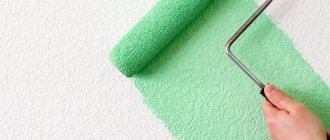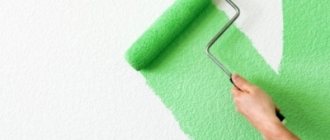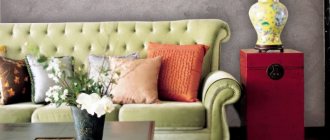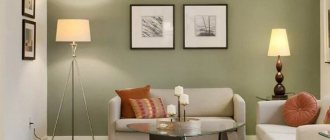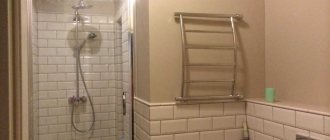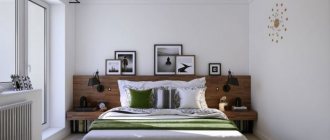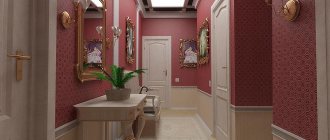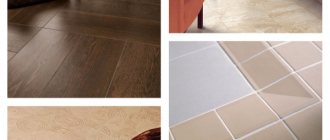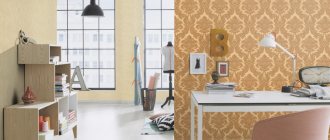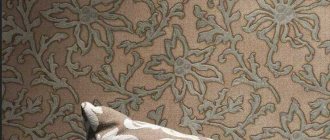What are sand effect paints?
This coating is at the same time one of the simple, and, at the same time, interesting and original, which are used for finishing. The resulting painted surface is textured, velvety and with different shades. This result is obtained by using paint and varnish substances and plaster components. Quartz sand, crushed shells and sparkles in the material play a decorative role.
Main varieties
Today, several varieties of decorative paint with a sand effect are produced. This composition is available in various colors and shades. In addition, not only primary colors are available to the consumer, but it is also possible to purchase compositions that imitate, for example, a metal surface; walls are made to look like gold, silver or bronze. After purchasing white decorative paint, it can be tinted in any desired color with any effect. Two main types of sand-based wall paint are produced:
- mother-of-pearl. Special components are added to this composition that reflect light and make the surface shiny and pearlescent. When a person looks at a wall from different angles, the surface will change its shade. Many people like the pearlescent effect, and they also produce silk dyes;
- matte. There are no additives in this paint that would reflect light. Matte wall paint with a sand effect also looks very attractive; it is more suitable for painting surfaces in soothing colors. After painting, the walls become rough.
Any type of paint with sand has a high level of strength and wear resistance, so these paints and varnishes can be used for interior finishing and for facade finishing work. Although the cost of such finishing is quite high, it is fully paid for by the long service life of the coating and the very attractive, original appearance of the walls.
Characteristics
Sand paint can be:
- Mother-of-pearl - the composition contains sparkling elements and substances that shimmer on the surface and look different depending on the angle of refraction of light, giving the walls a velvety feel.
- Matte - similar to textured, has no glare. The walls take on a rough appearance.
This coating is versatile and wear-resistant. Does not require careful maintenance, just washing with detergents is enough. The composition contains substances that prevent the formation of mold. The material is environmentally friendly and safe.
Disadvantages: high price and careful preparation of the coating surface.
Advantages of sand-based paints
Sand paint compositions are water-soluble paints, so they are easy to apply. Stains that accidentally end up on the floor can be easily cleaned without using solvents.
Main advantages:
- High adhesion. Good adhesion to the prepared base ensures a long service life of the coating.
- Ecological cleanliness. The ingredients contained in the paint will not harm health, so it can even be used in children's rooms.
- Immunity to mold and fungi, as antiseptic additives are added to the mixture.
- At the base preparation stage, there is no need to use finishing putty, which reduces the cost of preparatory work.
- Simple application process. Even an inexperienced craftsman can paint walls with sand paint.
- Durability and abrasion resistance. Correctly applied paint ensures the service life of the decorative coating up to 10 years.
- Fade resistant. The finish retains its original shade and stylish appearance throughout the entire period of use.
Painted walls are easy to maintain. Dirt can be easily removed with ordinary detergents. If you want to give your apartment a unique look without spending a lot of time and effort, then sand-based paints are an excellent choice.
You may also be interested in painting for concrete, which allows you to create modern interiors in the high-tech style; decorative paint for walls with a velvet effect also gives excellent results.
Operational Features
A special feature of working with finishing materials is careful preparation of the surface for application. The further operation of the coating depends on the quality of this work. Therefore, it is important to comply with the necessary requirements and recommendations:
- the surface must be cleaned of dust, dirt, previous coating and stains. It is better to use a vacuum cleaner and special solutions;
- areas of plaster that do not adhere well must be removed;
- seal the cleaned areas with plaster or gypsum mortar;
- widen the cracks using a trowel or chisel with a hammer, clean and seal with mortar;
- after this, putty the surface;
- After the putty has dried, sand the surface and treat it with a deep penetration primer, this ensures reliable attachment to the surface of the material.
It is necessary to apply putty and sand to the surface until an even and smooth texture is achieved.
Composition and effects
There are two main divisions of decorative plaster “sand” - matte and pearlescent. When walls are painted with mother-of-pearl coating, they acquire a silky and smooth feel. Thanks to the reflective particles in the pearlescent plaster, the finished walls shimmer in shades close to the base. The main reflective particles are crushed shells and various sparkles.
If you choose cheaper material, you can highlight brands such as Bayramix, Descartes, Elitas and others. And if a little more expensive, then “Veneziano”, “Baldini”, “Adicolor”. In terms of quality, one category is not much different from another; here everyone chooses according to their taste and composition.
Effects:
Sand dunes . Basically, this treatment is used if you want to depict a Moroccan or oriental style, since the wall turns out to be shimmering. As a rule, pearlescent paint is used in this technique.
Sandy winds . This effect is created due to the double layer of decorative plaster. The important thing here is to apply the layers in wide sweeping movements, crossing strokes with each other, drawing swirls. After drying, you should sand the surface so that the color becomes richer.
Pebbled leather effect . To create this effect, you need to resort to using a stencil (when you apply the second layer). Sanding is also recommended.
Burlap effect . You can achieve it by working with a small bristle brush. How much to manifest is up to you to choose.
Decorative paint for rooms with sand effect: application technique
Surface preparation:
- cleaning, leveling, puttying and sanding.
- The paint is applied to the surface using a thread or fur roller. Thickness from 1 mm to 3 mm.
- After a couple of minutes, a foam roller with a fine texture is used to lift the paint and a relief is formed.
- Using a rubber spatula, press the surface either in different directions or in one direction, depending on the idea.
- The paint dries within a day.
Application process
The most commonly used method for applying the mixture is called “Spraying”. It involves two layers of decorative sand plaster. In this case, the bottom one acts as a base, and the top layer provides a decorative effect.
For the simplest option, you will need a broom and a stick. The broom is lowered into a container with the prepared plaster solution, and then hits the stick so that the splashes hit the wall. Drops or flakes form on the surface, which creates relief.
Another application method is called the "Italian finish". It differs in that the second layer is applied immediately after the first, without waiting for it to dry. After all layers have completely dried, the surface is sanded.
Sand paint: interior solution
Sand paint has a wide range of colors.
Deep tones are suitable for the living room; they make the room cozy. It is not advisable to use bright colors for the kitchen. They get dirty faster and cause appetite. It is better to use darker colors, dark blue works great. Such shades hide imperfections, dust is invisible on them and, moreover, reduce the feeling of hunger. Gray and white shades look harmonious.
Beige and light colors work well for the bathroom. Greens and blues in reflection change the tone of the skin. If the bathroom is large, then with good lighting any shade will look great.
Main properties of decorative plaster Sand
Ordinary river sand gives decorative properties to this type of plaster. The subsequent appearance of the treated surface depends entirely on the application method itself, while maintaining the most important properties, the naturalness and naturalness of the surface.
But, despite all the decorative qualities, Sand plaster has a large number of useful properties:
- Resistance to moisture. Thanks to this quality, Sand decorative plaster can be wet cleaned. In order to enhance this property, you can additionally treat the surface with decorative plaster applied with wax.
- Vapor permeability. This quality allows you to maintain comfortable conditions in the room. That is, the surface calmly absorbs and releases moisture, regulating the optimal microclimate in the room.
- Long service life. This feature depends only on impeccable compliance with all operating conditions.
- Resistance to fungus and mold, especially if the main composition of the Sand plaster includes fine quartz.
Advice from professionals
To ensure that the painted surface looks perfect, experts advise:
- Prime the first layer with gypsum-based plaster, so it will dry faster. At the final stage, acrylic putty is perfect; it has antibacterial properties.
- To work with sand paint, use a wallpaper spatula.
- If desired, you can create the main shade yourself: mix the desired colors. The main thing is to use paints of the same brand and consistency.
- There should be no drafts in the room while the coating is drying. When the coating has dried, it is advisable to apply a protective agent or varnish the surface.
Sand paint is a versatile and durable material. With its help it is easy to create a unique interior.
Photos in the interior
This type of textured plaster is absolutely universal - it is perfect for both exterior cladding and interior decoration. A decorative element in a regular solution appears by adding quartz sand to it. Exactly how the wall will look directly depends on the type and method of applying the mixture, of which there are quite a few.
Sand-effect plaster, like many other modern decorative coatings, has many advantages:
- Moisture resistance . This useful property will allow you to easily carry out wet cleaning in the future and easily wipe off various contaminants from the wall. Some craftsmen, for even greater protection from moisture, treat the wall with special construction wax.
- Absorption of steam and release of moisture , which allows you to regulate the climatic conditions in the room. Thanks to this, “sand” can be safely applied to the walls of the kitchen or bathroom.
- Long term use guarantee . A long service life can be achieved only if the finishing instructions are followed, as well as the necessary conditions for using the coating.
- Mold protection . Even if the room itself is quite damp, you should pay attention to the plaster material with quartz in its composition, then you don’t have to worry about harmful bacteria.
- Large selection of designs . You can choose a pattern to suit every taste; it will usually depend on the application technique and composition.
You can see what sand plaster looks like in the interior in the photo:
